Gomer Pyle, U.S.M.C.
By E. Kitzes Knox
First Published December 1965
Published by Pyramid Publications, Inc.
144 Pages
I’ve only seen a handful of episodes of Gomer Pyle, U.S.M.C. and those were watched over two decades ago. So I freely admit to not being familiar with the show or the characters. Still, after reading only a few pages I was pretty confidant that something wasn’t quite right with many of the facts included in this novel. Everyone knows Gomer Pyle was born and raised in Mayberry, right?
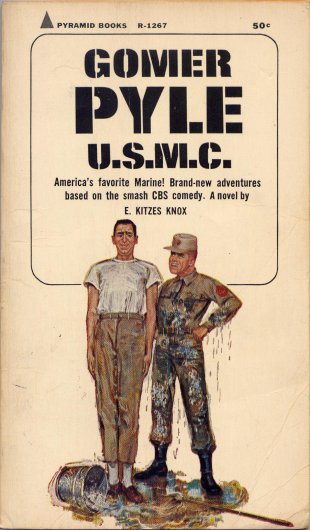
Gomer Pyle, U.S.M.C. Front – Copyright 1965 Pyramid Publications, Inc.
According to the novel, he was born in a little town called Sinking Springs, where his relatives and their many strange but lovable friends still reside. At first I thought maybe the character of Gomer Pyle was said to have been from Sinking Springs originally. When I checked Kurt Peer’s wonderful TV Tie-Ins: A Bibliography of American TV Tie-In Paperbacks, however, he confirmed that the novel gives “a back-history that’s contrary to Gomer’s roots as a gas station attendant on The Andy Griffith Show.”
Peer also reveals that E. Kitzes Knox is a pseudonmyn for Esther Kitzes and Helen Knox and says there was a second Gomer Pyle, U.S.M.C. novel, by Robert Tralins and called Gomer Pyle’s Secret Weapon, written by never published. Mysterious. Aside from changing Gomer’s back story, the novel gives Sgt. Carter’s full name as Harold Q. Carter rather than Vince Carter like it was in the TV series. And Gomer’s pals are Regis (Gomer calls him Ray and his name is always written Regis-Ray), Jim Holmes and Fat Gorley, none of whom appeared in the TV series. If the novel had been written before Gomer Pyle, U.S.M.C. was on the air I could understand Sgt. Carter’s name being wrong and Gomer having a bunch of friends never mentioned on screen. But to ignore Mayberry?
None of this detracts from the story itself. It’s still enjoyable. I could have done without the capitalization to show emphasis (“PYLE! At your feet and at ATTENTION!” “PYLE. YOU ARE SEVEN MINUTES LATE!”) and some of the folksy charm exhibited by the residents of Sinking Springs borders on the disturbing. But it’s a fun story involving tens of thousands of letters and an equal number of cakes and pies and cookies, a general who refuses to be driven anywhere, ramps (related to leeks), a relative of Gomer building a pool in his backyard and the Singing Drums, a musical family from Sinking Springs consisting of Daddy Drum, Mama Drum, Melody Belle, Xylo Viola, Clara Nettie, Mandy Lynn, Reveille Lullaby, Organ, Harmony Carol and Hymn (the only boy).
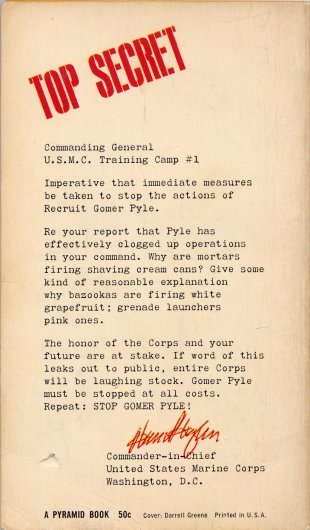
Gomer Pyle, U.S.M.C. Back – Copyright 1965 Pyramid Publications, Inc.
Gomer, of course, gets himself into loads of trouble without intending to but winds up befriending the aforementioned general and has a parade thrown in his honor at Sinking Springs, attended by his whole platoon. And Sgt. Carter falls for one of the Drum sisters and gets to meet the whole Drum family. For all its inconsistencies relating to the television series, Gomer Pyle, U.S.M.C. is a cute, short novel that fans of the series may find amusing. I doubt anyone else will, though.

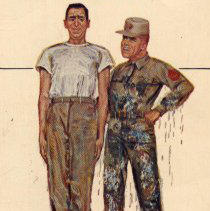
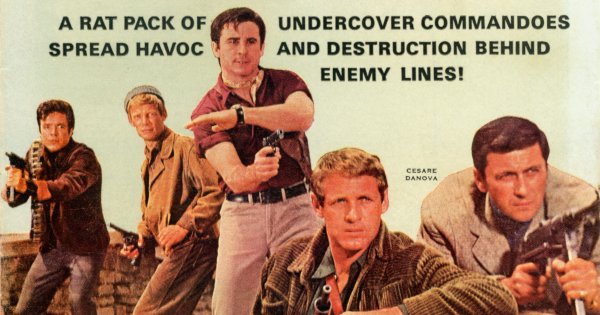
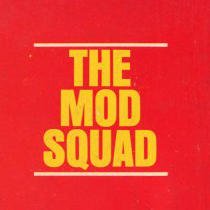
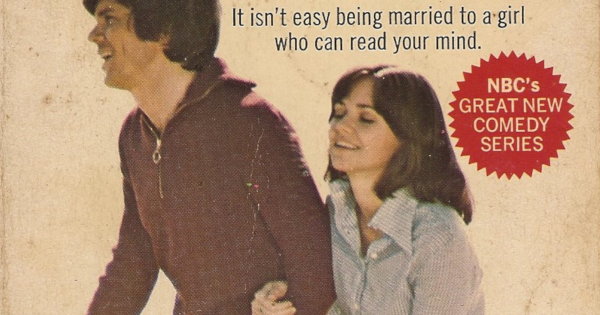



This was an “unauthorized” novelization of the series- if it HAD been, the copyright would have been in “Ashland Productions”‘ name (Andy Griffith’s production company was responsible for the TV show). But it’s in the PUBLISHER’S name, so that means it’s THEIR version of the series, and it probably meant they didn’t want to pay money to the production company for a “proper” authorization. So, Esther and Helen (as “E. Kitzes Knox”) created an “abstract” of the two main characters, added some new ones, and altered the name and locale of Gomer’s home town.
And it was perfectly acceptable- just look at Bantam’s paperback version of “I DREAM OF JEANNIE” from early 1966. “Unauthorized” all the way, with author “Dennis Brewster” registering the copyright on the novel as well {I suspect “Brewster” was really AL HINE, who wrote the authorized “BEWITCHED” paperback novel for Dell in February 1965}, with a slightly different “backstory” and new characters….AND a major “detour” from the TV series’ storyline. You have to read it to believe it {Jeannie’s mother in love with Colonel Bellows? Roger and Jeannie’s sister “Nunz” a twosome?? Jeannie lives in her bottle as SMOKE???}.
As to why the second projected “GOMER PYLE” novel was never published, I believe it had something to do with “Ashland Productions” telling Pyramid to “cease and desist” their printed version of “Gomer”, or face a BIG FAT LAWSUIT! But that didn’t stop the publisher from issuing second and third printings of their book, right into 1968.
Personally, I like it!
One thing I found amusing about the story is the way television news anchors and reporters were slightly lampooned: the name of the network correspodent who interviews Gomer on TV (just before he and his platoon journey to Sinking Springs) is identified as “Selfridge Wickerknight”….now honestly, when was the last time you heard of a reporter with THAT kind of a “boorish” name on TV? Or the anchor of that newscast, itself: “John Shirtwaist”!!!!!!!!
The GOMER and JEANNIE novels *might* have been unauthorized, but not likely. The copyrights are unusual, but may have been contractual separation of rights arrangements. (TV tie-ins were still a fairly young genre then, barely more than a decade old, and the rules were not yet codified. And in the UK, the authors of the novel [even if it was a novelization] *usually* held all or part of the copyright.)
As for the discrepancies, what most people forget is technology and math. (1) VCRs did not exist then, in the context of common home appliance; there was no way to w2atch episodes except when broadcast, You could take assiduous notes to get minutiae right, but that was about it. The author of a tie-in had to rely on his memory and whatever materials he was given, which were often not extensive. On top of this (2) a lot of these novels were written to be released shortly after the series started airing, or not too deep into the first season. Which meant they had to be written BEFORE the show aired. The author might not be given a comprehensive supply of materials to work from. A description and some photos might be it, Maybe a pilot script, maybe as show bible. And after that, he had to take his best guess.
There are a few cases where authors *deliberately* did their own thing (Keith Laumer’s approach to THE INVADERS comes to mind), or developed their on kind of “alternate universe” continuity, in which they expanded on the series characters and concepts through there filter of their own novelistic sensibility (the I SPY novels by Walter Wager as “John Tiger” come to mind), but those “reactive” changes were rarer. Usually the changes were about nothing so much as needing to meet a publisher’s quick-turnaround deadline.
Pocket Books DID, by the way, release an unauthorized novel by Don Tracy as “Roger Fuller” based on the pilot of THE FUGITIVE, and series creator Roy Huggins sued them over it and won. I don’t know the full background, but it seems unlikely that Pocket would have brazenly and deliberately published “out of wedlock.” I think it’s far more probable that someone assumed he had rights he *didn’t* have, based on a misunderstanding of a conversation or a draft contract or letter that hadn’t been finalized or vetted properly.